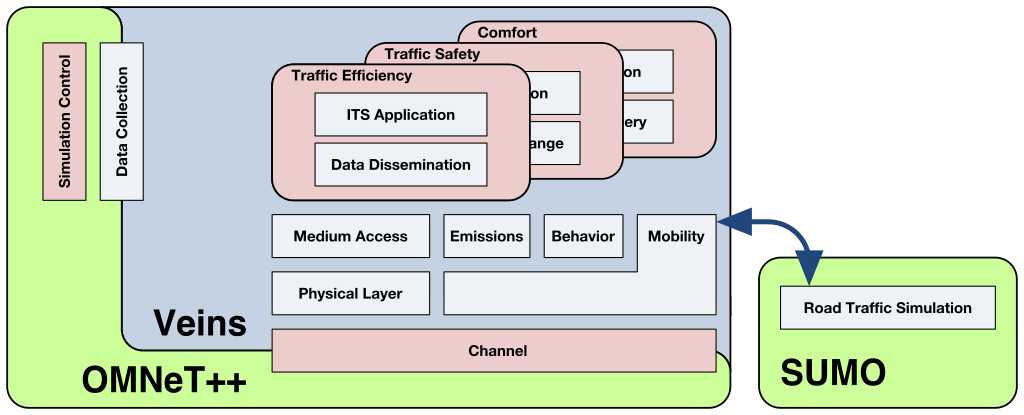Documentation
Veins, the Open Source vehicular network simulation framework, ships as a suite of simulation models for vehicular networking. These models are executed by an event-based network simulator (OMNeT++) while interacting with a road traffic simulator (SUMO). Other components of Veins take care of setting up, running, and monitoring the simulation.
This consitutes a simulation framework. What this means is that Veins is meant to serve as the basis for writing application-specific simulation code. While it can be used unmodified, with only a few parameters tweaked for a specific use case, it is designed to serve as an execution environment for user written code. Typically, this user written code will be an application that is to be evaluated by means of a simulation. The framework takes care of the rest: modeling lower protocol layers and node mobility, taking care of setting up the simulation, ensuring its proper execution, and collecting results during and after the simulation.
Veins contains a large number of simulation models that are applicable to vehicular network simulation in general. Not all of them are needed for every simulation -- and, in fact, for some of them it only makes sense to instantiate at most one in any given simulation. The simulation models of Veins serve as a toolbox: much of what is needed to build a comprehensive, highly detailed simulation of a vehicular network is already there. Still, a researcher assembling a simulation is expected to know which of the available models to use for which job. To give a trivial example, one would not want to use a path loss model designed for cities to simulate a freeway scenario.
Veins is an Open Source vehicular network simulation framework. What this means is that it (and all of its simulation models) are freely available for download, for study, and for use. Nothing about its operation is (or needs to be) kept secret. Any simulation performed with Veins can be shared with interested colleagues -- not just the results, but the complete tool chain required for an interested colleague to reproduce the same results, to verify how they were derived, and to build upon the research performed.
As discussed before, with Veins each simulation is performed by executing two simulators in parallel: OMNeT++ (for network simulation) and SUMO (for road traffic simulation). Both simulators are connected via a TCP socket. The protocol for this communication has been standardized as the Traffic Control Interface (TraCI). This allows bidirectionally-coupled simulation of road traffic and network traffic. Movement of vehicles in the road traffic simulator SUMO is reflected as movement of nodes in an OMNeT++ simulation. Nodes can then interact with the running road traffic simulation, e.g., to simulate the influence of IVC on road traffic.
The simulation models of Veins constitute the current state of the art in vehicular network simulation research. Aside from numerous publications that base their conclusions wholly or in part on simulations conducted with Veins, many proposed new and improved simulation models or techniques, implemented for the first time in Veins.
Please refer to the following pages for more information.
- Veins Tutorial
- Frequently Asked Questions (FAQ)
- Instant Veins
- Upgrading
- veins_launchd (Optional)
- Modules
Information about the simulators and about TraCI can be found on their respective websites:
